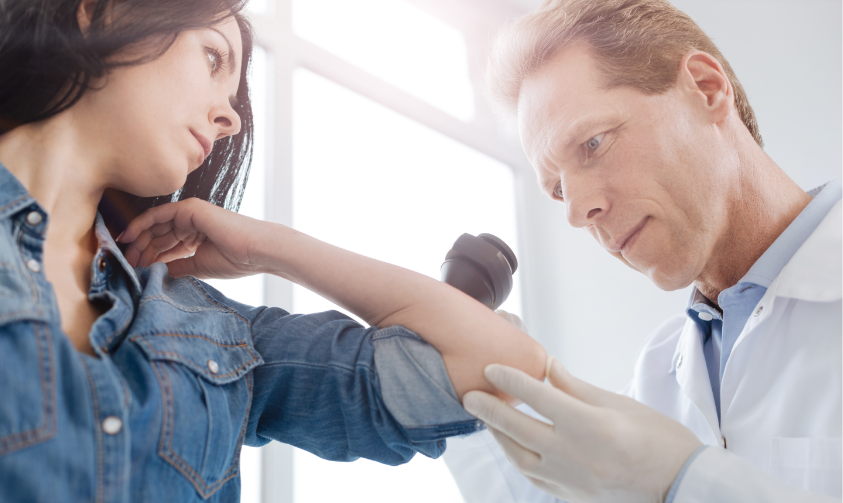The skin is the body’s first line of defense. So, when it comes to diagnosing health problems in their earliest stages, it’s no surprise that your skin can be a great indicator. There are many chronic and systemic illnesses with early warning signs that can present as skin changes – changes in color, rashes, changes in texture – which can signal that it’s time to seek help for health concerns that may be more than skin deep. Although this is not a comprehensive list, we’ll review some of the many skin symptoms that may signal health problems. According to Dr. Nicholas Crowley of U.S. Dermatology Partners Shoal Creek, “Certain skin findings can be early signs of systemic disorders, which can help to aid in accurate diagnosis of some conditions.”
1 – Skin Changes in Diabetes
Diabetes can impact the entire body – including the skin. A patient may be considered diabetic if they have high blood glucose (too much sugar in the blood). If you’re struggling with diabetes or prediabetes, you may notice a number of changes to your skin, including:
- Lower leg rashes that may appear as dark, scaly patches on the shins.
- Dark and velvety areas of skin in areas such as the underarms, neck, groin, elbows, knees, and knuckles
- Tight, thickened skin on the hands and fingers
- Dry, itchy skin
- An increased risk of infection and difficulty healing wounds
- Decreased sensation or numbness in hands and feet
2 – Skin Discoloration
Changes in skin tone can occur due to external causes such as sun exposure, but there are also internal health conditions that may cause skin discoloration. Yellow skin may be a symptom of jaundice, which is due to increased levels of bilirubin. This can be common in infants but also can present later as a sign of pancreatic or liver disease.
3 – Scaly Patches and Nonhealing Sores
Scaly patches, nonhealing sores, and painful bumps in sun-exposed areas such as the face can be indicative of skin cancers, such as squamous cell carcinoma or basal cell carcinoma. These are the two most common forms of skin cancer.
4 – Red Cheeks
People can become flushed due to embarrassment, fever, medications and a number of other reasons but if your face appears to be red often, this may be a sign of another condition. Possible causes include common skin conditions such as rosacea and seborrheic dermatitis along with other causes such as lupus, which can affect other organs in your body. Lupus may present with a rash in a butterfly shape across the nose and cheeks.
5 – Chronic Itch
There’s nothing strange about itchy skin. Your body is constantly coming into contact with irritants like cold weather, itchy wool sweaters, and allergens. However, changes in kidney function, gall bladder function, and certain medications can also all cause itchiness.
6 – Skin Abscesses – Boils
Skin abscesses, more commonly referred to as boils, are fluid or pus-filled bumps on the skin that can be painful. Abscesses most often occur due to bacterial infection in the skin. Recurrent boils or abscesses in certain areas such as the groin, underarms and under the breasts can be signs of a dermatologic condition known as hidradenitis suppurativa. Depending on the severity, this condition may be treated with a variety of topical or systemic medications.
When it’s Time to Call U.S. Dermatology Partners
Many changes in the skin can be linked to underlying health concerns. At U.S. Dermatology Partners, we can help you to treat many skin changes and skin conditions. Our skilled professionals are also dedicated to partnering with patients to determine any underlying health problems that may be causing skin symptoms. If you want to learn more about maintaining your optimal health – inside and out – complete our simple, online appointment request to get started with U.S. Dermatology Partners.
Find a location near me
or

